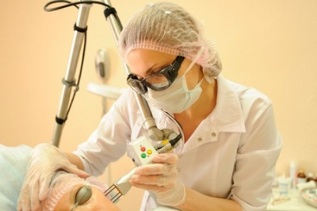
Fractional rejuvenation involves the use of lasers. This is a very complex procedure to solve various skin problems that inevitably arise with aging. It requires high professionalism from the experts who run it. Only specialists with medical education and complete courses to work with laser equipment are entitled to laser rejuvenation. Performing the procedure at the clinic in question with an unqualified beautician, you can get the negative effects instead of the desired rejuvenation.
Fractional laser treatment is an ideal choice for those looking for a way to rejuvenate the face without surgery. By the way, this method is used not only on the face, but also on the body. In particular, using lasers, the possibility of scars and striae is not visible. Therefore, laser rejuvenation will be interesting for those who have long been interested in the problem of how to get rid of stretch marks on the body.Various fractional laser rejuvenation
Fractional lasers do not send a single ray, but many microscopic rays, which allow you to act on the skin softer and smoother.
Fractional laser rejuvenation is divided into two types:- The first type of fractional rejuvenation is often called laser resurfacing. During the resurfacing, the laser removes a very small area from the top layer of skin, which is located at a certain distance from each other. It activates the regeneration process on the skin. This procedure uses carbon dioxide laser.
- The second type of fractional rejuvenation is the best ray effect on the skin area at a strictly determined depth. At the same time, the surface of the skin is not injured, and in the deep layers of the skin, collagen production is activated and the laser-removed skin area is filled with new cells.
Different clinics use different types of lasers, but the principle of laser rejuvenation methods is the same in all cases: suffering from controlled damage to the skin, leading it to active recovery and renewal.
In each particular case, the doctor decides which laser technique is most appropriate. Prior to each procedure, the laser is individually adjusted for each patient.
Skin care after fractional skin rejuvenation

The doctor who performs the procedure will tell you how to treat your skin after laser rejuvenation. The selection of cosmetic products depends on the skin type, individual characteristics, as well as the task and scale of the procedure performed.
On days 2-3 after the session, a crust forms on the skin, which is rejected in 3-4 days. At this time, it is necessary to use the cream recommended by the doctor. Then, for 1-2 months, it is necessary to apply good sunscreen on the skin before each one goes out, and apply a nourishing regeneration cream at night.
Importantly, laser rejuvenation not only corrects age-related changes, but also slows down the aging process itself, thus triggering skin cell renewal mechanisms.Who is the appropriate fractional rejuvenation and by which procedure is it combined
This procedure is always done only after consulting a specialist first. With very significant age-related changes, laser resuscitation will be very useful, rather than laser rejuvenation. In some cases, it is impossible to do without plastic surgery at all: blepharoplasty, endoscopic face lift or thread introduction for lifting. But here too, hardware techniques, especially laser rejuvenation, will help enhance and maintain its effect.
Plasmolifting and mesotherapy are combined with laser techniques, including biorevitalization with hyaluronic acid.
Laser rejuvenation procedures are not suitable for pregnant and lactating women, people suffering from cancer, diabetes mellitus, high blood pressure, psoriasis and dermatosis. Herpetic rash and inflammatory processes in the affected area are also contraindications to the procedure. Laser rejuvenation is not recommended for people with keloid scars or vitiligo family history.




















